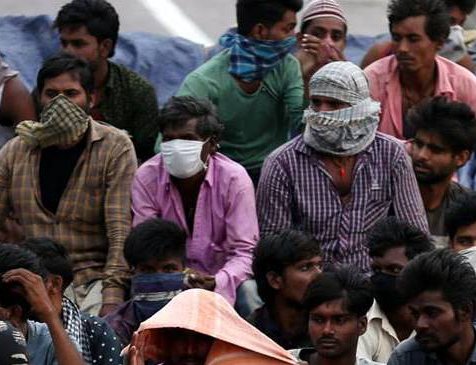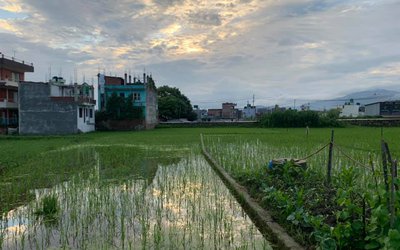
Now the people of the world are divided into two thoughts; Covid-19 prevention and control, and proximity of hunger due to the prolonged lockdown. Especially the rich are more afraid of the disease because the hunger never touches them. But the oppressed-class people are not as worried about the disease as they are about hunger. The bare-foot-marching people seen in the highway shows the same as there is no place to eat on the way due to the lockdown, neither they have affordability. Even now, with the emphasis on prevention of Corona infection around the world, international organizations and nation-states do not seem to be as concerned about starvation as they seem to have been. People are dying of hunger three times a day more than Covid-19. This number is estimated to have increased further in the current lockdown. So, journalist Paula Froelich used ‘luxury’ to the later part of the lockdown in an article of New York Post. It is because the well-off people and elites have been ‘enjoying’ the lockdown whereas the oppressed section of people are stranded and traumatized with the shock of life, livelihood and hunger.We can judge itsimply through the social media posting as well. In fact, the prolonged lockdown has caused massive fissures in our society - mainly between those who can afford to stay home and those who can’t. Working-class and blue-collar people, many of whom live month to month, are destitute due to the prolonged lockdown. So, itbecame luxury to tackle to Covid-19 for the well-off or elites whereas it is becoming fatal to hunger to the working-class people. It looks like a romanticism on poor.It seems it isthe easy going measure to the government as well.
Nutrition is the one of the lead ingredients for the naturalhealing of the disease. The human body is designed to prevent from the external attack and to build the immune system needed for self-healing. Healthy body, psychosocial wellbeing and nutritious food are the essence of the immune system. If someone is to stay in confinement for a long time, s/he will lose all these things resulting the loss in immunity, which will lead to a sudden onset of any disease.So, people have to keep active themselves to gain the immunity. To keep human body active and productive s/he needs to work in a regular manner.Therefore, in order to fight the disease, it is very important to control hunger.The Global Nutrition Report 2020 published recently highlighted the link between inequities in the food system and health inequalities. While undernourished people have a weaker immune system and can be at greater risks of the virus, people with obesity and diabetes have been found to be more likely to die from Covid-19. The report warned that there is a real risk that, as nations strive to control the virus, the gains they have made in reducing hunger and malnutrition will be lost.

The death toll of Covid-19 each day, several times it crossed 7000, is shocking everyone. However, very few people are aware that hunger is the biggest cause of death even today. Ten million people die every year (more than 25,000 per day) due to hunger and hunger related diseases. Only eight percent are the victims of hunger caused by high-profile earthquakes, floods, droughts and wars. Over 2.5 million Indians die of hunger every year that counts over 7,000 each day. A child dies of starvation every ten seconds. As per UNICEF report (2018) approximately 3.1 million children die from undernutrition each year. That is nearly half of all deaths in children under the age of five. It can be estimated that this number has increased significantly in the current situation of lockdown. The WFP estimates that 32 million schools in 120 countries are closed due to the current halt. It is certain that a large number of children will be malnourished when their parents stop working. According to the ILO, about 2.7 billion workers (four out of five of the world's human resources) are in full or partial layoffs. It has made the poor even more vulnerable. Accordingly, famine has already started and further exacerbated as supply chain disruptions have disrupted food supplies.
The Harvard professor Dr Cornel West opined that economic viruses were already at work before Corona viruses.UN agencies had forecasted acute food insecurity for 2020 driven by conflicts in Yemen and Central Africa and the Middle East, an outbreak of desert locusts in East Africa, extreme weather events in the Caribbean, adverse climate in the Sahel and West Africa and socio-political crisis and high food prices in Latin America, even before the Covid-19 outbreak.Some821 million people go to bed hungry every night all over the world, and the latest Global Report on Food Crisis reveals that 135 million people on earth are marching towards the brink of starvation. The WFP analysis shows that, due to the current pandemic, an additional 130 million people could be pushed to the brink of starvation, that is a total of 265 million people, by the end of 2020.About two billion people are overweight or obese and 30 percent of all deaths are linked to nutrition-related diseases.As millions of people faced being pushed to the brink of starvation, WFP warns of a “hunger pandemic”.If we don’t prepare and act now – to secure access, avoid funding shortfalls and disruptions to trade – we could be facing multiple famines within a short few month.
According to UNCTAD, the UN body dealing with trade, global trade is projected to fall by a record 27 percent in the second quarter of the year.According to IMF report (2020), for the first time since the Great Depression in the 1930s, both advanced economies and emerging market and developing economies are in recession and projected to contract sharply by –3 percent in an average in 2020. The ILO estimates that the global market will lose up to 25 million jobs due to the epidemic. The most vulnerable people in society have been the first and hardest hit. It will have a serious impact on labour-sending-countries as it will lead to a sharp decline in remittance income. Households dependent on remittance income will lose the ability to cope with hunger. A recent Oxfam report estimates that the corona epidemic will add 500 million poor people worldwide. This will widen the proximity of the famine. However, all these figures are interim. The actual data may be even more alarming because its multidimensional impact has not been studied properly. In a country like Nepal that hashad a poor healthcaresystem, informal and unorganized labor market, economy based on remittances and import tariffs, and weak governance capacity the impact and panic of the Covid-19 is even harder. In countries where a large portion of income has to be spent on food; and unemployment benefits, insurance and other social protection provisions are not effective famine is a natural consequence. The longevity of this crisis can be projectedwith the fact that the WHOadvised the need of maintaining social distance by 2022.
According to the FAO’s 2019 report on Nepal, about 2.5 million (8.7 percent) Nepalese are malnourished. It is still in the "Sensitive" (Index 20.8) category in the World Hunger Index. Nepal's own statistics (Nepal Demographic Health Survey 2016) shows that 4.6 million people are suffering from food insecurity, with 20 percent of households mildly food-insecure, 22 percent moderately food-insecure, and 10 percent severely food-insecure. Similarly, about one million (36 percent) children under the age of five are severely malnourished. Karnali and the hilly regions of the Far-west province are the centers of hunger. Every Nepali has to spend about 50 percent of their income on food stuffs, while about 22 percent of households have to spend up to 75 percent of their income on food. Despite being an agricultural country, it suffers from about 85,000 metric tons of food deficiency annually. The amazing fact is that 60 percent of the farmers themselves are suffering from food shortage. Remittance income is an effective coping strategy to meet food deficiency.According to a 2009 World Bank study, about half a million households, including those in India, were employed abroad. This number of migrant-workers going abroad,except India,is estimated to have reached 2.5 million. From this, the country received Rs. 784 billion in remittance income last year alone. Now this income seems to be declining drastically. The WB estimates remittance to decline by14 percent resulting in a loss of approximately 145 billion NRs in 2020.
It is estimated that about one million people working abroad, except India, will be back immediately after the lockdown is released or eased.Likewise, according to the latest labour force survey report, out of 20.7 million working age people only 7.1 million are in the employment. Out of the employed people, around 62 percent work in informal sector that is the most unsecured job. Now most of the jobs are halted and it seems around 50 percent jobs, especially informal ones, are hard to revive. About 500,000 youth are coming to the labour market each year. It creates harsh pressure to the government to create employment in a massive scale. This is sure that lack of employment weakens the coping strategy against hunger. In the Great Earthquake of 2015, 1.4 million people were in urgent need of food aid and about 1 million people were pushed below the poverty line. But the current impact seems to be even more serious. If present trends continue, food security is expected to increase among: households engaged in informal labor, precarious labor, service sector and daily wage work, as well as households with return migrants and income losses. Moreover, the transportation constrainsare posing problems in all the four pillars of food security; availability, access, utilization and stabilization.
According to the UN, from farm to fork, the food supply chain accounts for 29 percent of global greenhouse gas emissions as it has been dealing by the big corporate houses. About a third of all food produced goes to waste.It would preserve enough food to feed 2 billion people- more than twice the number of undernourished people across the globe. It would also increase household income, improve food availability, reduce food imports and improve the balance of trade. However, for that it needs to restore the distribution chain intact, otherwise, the lockdown may further increase the food wastage as the farmers being not able to do the harvesting properly and bring production to the market.
The Zero Hunger Challenge, an international commitment envisioned for “world without hunger”, has reemphasized ending hunger by 2025 sustainably. Likewise, the United Nation’s SDGs call on all countries to end hunger in all its forms by 2030. But the present pandemic made it harder to achieve these goals in accredited time. It does not seem possible to revive the economy and the livelihood of the people through the continuation of its ongoing plans, strategies, structures and working style. For this, the nation- state needs to make focused plans and strategies with smart operational structures for each level of governments. The state of transition, a recent change in governance system with federal structure, has posed an additional challenge to our country, Nepal. It also created a situation to rethink on our political system and governance approach. The country's economy and the livelihood of its citizens cannot be revived in an equitable manner by following the existing policies as usual.
It needs focused protective intervention from the state which focuses on building local food regime-peasants command over food system- that La Via Campesina, the peasants’ movement, has been campaigning since 1996. The Constitution of Nepal has included the Right to Food and Food Sovereignty as the fundamental rights while the Act (2018) has detailed various measures to its realization. The implicit spirit of the food sovereignty is to build the local food regime thatregenerates human immune, protects environment, respects cultural diversity and rewards human pluralism. It strengthens the community resilience and also reduces carbon emission.
Now it is special time to reshape the economy in order to bring emancipatory shift in the life of the vulnerable people.For this,protective intervention or protectionism to restate the local food system, local production and market mechanism, and the local economy would help develop the independent and strong local government which will strengthen the federal system of the country. Not only that, it will lead the nation-state towards Liberal Socialism through transformative democracy. Inclusive society from bottom to top is the basic part of protective liberalism whereas building inclusive governance from the bottom is the hardcore strategy of the liberal socialism. Therefore, the ‘Coronomics’ can be the foundation for rising the new economic policy including local food regime, homegrown approach to eradicate hunger, and promote self-sufficient local economy.
(Dr. Bk is former Fulbright scholar and the author of the book 'Eradicating Hunger: Rebuilding Food Regime')
- Protective Liberalism: An Alternative to Neoliberalism, A Warming Agenda For WSF 2024
- Feb 13, 2024
- Caste-based Practices Decreased But Not Momentum: A Review Of The Studies Commissioned By FCD
- Mar 18, 2022
- The Social Life Of COVID-19 Pandemic: Escalating World Hunger
- May 27, 2021
- Rise Of Liberal Socialism To Reshape The Coronomics
- May 07, 2020
- Escalating World Hunger With The COVID-19 Pandemic
- Apr 12, 2020













